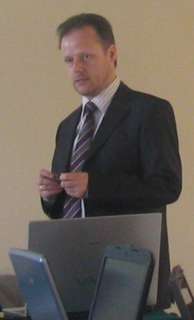"Emulate" Word Trados translation with TagEditor Thread poster: Antonín Otáhal
|
|---|
When my customer wants to get the "unclean Word file" but I prefer translating the file with TagEditor, I can imagine that translating in TagEditor and then using the updated TM on the Word file will get me there nearly automatically (except for the segments with formatting tags, of course ). ).
Is there any other way?
[Edited at 2006-02-18 11:48]
| | | | Heinrich Pesch 
Finland
Local time: 00:12
Member (2003)
Finnish to German
+ ...
| Save bilingual as...? | Feb 18, 2006 |
I have never tried this, but you probably can save the document as rtf and load it into Word.
Regards
Heinrich
| | | | Jerzy Czopik 
Germany
Local time: 23:12
Member (2003)
Polish to German
+ ...
| I´m afraid not | Feb 18, 2006 |
as "Save as billingual file" produces a *.ttx, which is unreadable in Word.
So to get an uncleaned file in Word you will need to process it in Word. When you do the translation in TAG Editor (which way I recently prefere), you will have to aplly the TM to the Word file and correct the fomatting, where bold, italic and so on were used.
HTH
Jerzy
| | | | Jaroslaw Michalak 
Poland
Local time: 23:12
Member (2004)
English to Polish
SITE LOCALIZER | Dirty trick? | Feb 18, 2006 |
Unfortunately I do not have time to check it, but it might just work...
When you translate, save the target file as doc. Then align the source document and the target document. Provided there are no segmentation problems, it should be quick enough.
That way you have a TM with what you did in TagEditor. The difference is that it does not have tags, but regular Word formatting.
I hope it works!
| | |
|
|
|
Antonín Otáhal
Local time: 23:12
Member (2005)
English to Czech
+ ...
TOPIC STARTER | Actually, the alignment seems unnecessary | Feb 18, 2006 |
since I can achieve what you describe just by running the automatic translation from the updated TM; but the formatting-tag problem is there all the time.
Oh well, it looks like this cannot be avoided.
Thank you all for your ideas.
Antonin
| | | | Jerzy Czopik 
Germany
Local time: 23:12
Member (2003)
Polish to German
+ ...
| I think you will be faster | Feb 18, 2006 |
if you translate and then format the document manually.
Provided the template settings are ok, ie the global formatting is not much changed, only for bold or italic to emphasize some things.
What I would do:
- Prepare the document in Word to achieve the font type and size and other text parameters do match with the corresponding style.
- Remove unnecessary line breaks and so on.
- Prepare the document in Word to achieve the font type and size and other text parameters do match with the corresponding style.
- Remove unnecessary line breaks and so on.
- Translate with TAG Editor.
- Change the setting for TAG penalty in your TM to 0 (zero)
- Apply this TM automatically to Word.
- Reformat where necessary.
If you set your Workbench to remove TAGs where no TAGs are in source (via Options - Translation Memory Options - Strip TAGs...) this should work quite quickly.
Should you have any other questions I might be able to answer - you have my email, so don´t hesitate to use it at any time you might wish.
Regards
Jerzy
▲ Collapse
| | | | Olaf (X)
Local time: 23:12
English to German
| Use Copy & Paste | Feb 18, 2006 |
I don't know if this still works with the current version, but in older TE versions you could simply select the whole document in TE and then copy and paste it to Word and save it as an RTF document.
Olaf
| | | | Jaroslaw Michalak 
Poland
Local time: 23:12
Member (2004)
English to Polish
SITE LOCALIZER | You're missing the point! | Feb 19, 2006 |
Alignment is not the same as translating from the TM!
The TM you got translating in the TE will be different than the TM created on the basis of the alignment. When you align the .doc files and import the result, the formatting in the TM is not represented as tags, but as internal Workbench formatting. Which means that no matter how badly is the document formatted, you will get all 100% matches.
I have just run a short test and it works perfectly. I have used a s... See more Alignment is not the same as translating from the TM!
The TM you got translating in the TE will be different than the TM created on the basis of the alignment. When you align the .doc files and import the result, the formatting in the TM is not represented as tags, but as internal Workbench formatting. Which means that no matter how badly is the document formatted, you will get all 100% matches.
I have just run a short test and it works perfectly. I have used a short test document with lots of bolds and italics in it. If you want, I can describe the whole procedure step by step. ▲ Collapse
| | |
|
|
|
Antonín Otáhal
Local time: 23:12
Member (2005)
English to Czech
+ ...
TOPIC STARTER | To Jabberwock | Feb 19, 2006 |
You are right, I did not realise that aspect.
Thank you.
Antonin
| | | | Jerzy Czopik 
Germany
Local time: 23:12
Member (2003)
Polish to German
+ ...
| I still would not go for Alignment | Feb 19, 2006 |
It is enough, that there are uncommon abbreviations in the file or the author has written the text badly, missusing dots, spaces and so on - you will then have a lot of work to collect your aligned result.
Usually it is faster to reformat the document manually.
Best
Jerzy
| | | | Jaroslaw Michalak 
Poland
Local time: 23:12
Member (2004)
English to Polish
SITE LOCALIZER | Depends on the text... | Feb 19, 2006 |
I am not saying that it will be faster than formatting it manually
It really depends on the source document - how much manual formatting is included and how many segmentation issues might occur (which are the main problem during alignment).
| | | | Éric Cléach 
France
Local time: 23:12
Member (2005)
English to French
| Segmentation sometimes differs between TagEditor and Workbench | Feb 21, 2006 |
Well, there is also another problem: it seems that TagEditor doesn't always segment DOC files the same way as Workbench would do in Word, so you cannot always "translate to fuzzy" a whole file already translated in TagEditor.
I just finished translating a 5000 words DOC file within TagEditor, ie all segments are in the TM. If I run an analysis with Workbench on the original source DOC file, I still have about 500 words in 95-99% segments.
If I recreate a TTX with TagEdi... See more Well, there is also another problem: it seems that TagEditor doesn't always segment DOC files the same way as Workbench would do in Word, so you cannot always "translate to fuzzy" a whole file already translated in TagEditor.
I just finished translating a 5000 words DOC file within TagEditor, ie all segments are in the TM. If I run an analysis with Workbench on the original source DOC file, I still have about 500 words in 95-99% segments.
If I recreate a TTX with TagEditor from the source DOC file and run an analysis on this TTX, I only get 100% matches.
Depending on the formatting/layout (and on the quality of this formatting), I do think it can be quicker to align the DOC files, as it can also be quite time-consuming to "correct" the 95-99% matches.
Now, that would surely help a lot if you could save/export RTF/DOC bilingual files from TagEditor. I do hope that SDL will implement this feature in Trados 2006...
Also, depending on the source document, it can be even easier to copy all the document in TagEditor and to paste everything in Word. This works perfectly with files exported from FrameMaker, for instance.
Eric
[Edited at 2006-02-21 16:46] ▲ Collapse
| | |
|
|
|
Jerzy Czopik 
Germany
Local time: 23:12
Member (2003)
Polish to German
+ ...
| The segmentation is nothing what cannot be changed | Feb 21, 2006 |
And it rather sometimes should be changed.
So it is advisable to use enlarge or shorten segment function to get only full sentences in segments.
And alone the 1% penalty for missing TAGs will bring you to some not-100% matches when analysing Word.
Everything depends on the kind of document we are working with.
As for copy&paste into Word - I don´t think you will get a formatted billingual Word file in that way. What you will get will be a tagged file, which... See more And it rather sometimes should be changed.
So it is advisable to use enlarge or shorten segment function to get only full sentences in segments.
And alone the 1% penalty for missing TAGs will bring you to some not-100% matches when analysing Word.
Everything depends on the kind of document we are working with.
As for copy&paste into Word - I don´t think you will get a formatted billingual Word file in that way. What you will get will be a tagged file, which is perfectly good for Frame import, but will not help to provide the customer with the requested uncleaned Word file.
Regards
Jerzy ▲ Collapse
| | | | To report site rules violations or get help, contact a site moderator: You can also contact site staff by submitting a support request » "Emulate" Word Trados translation with TagEditor | TM-Town | Manage your TMs and Terms ... and boost your translation business
Are you ready for something fresh in the industry? TM-Town is a unique new site for you -- the freelance translator -- to store, manage and share translation memories (TMs) and glossaries...and potentially meet new clients on the basis of your prior work.
More info » |
| | Anycount & Translation Office 3000 | Translation Office 3000
Translation Office 3000 is an advanced accounting tool for freelance translators and small agencies. TO3000 easily and seamlessly integrates with the business life of professional freelance translators.
More info » |
|
| | | | X Sign in to your ProZ.com account... | | | | | |









